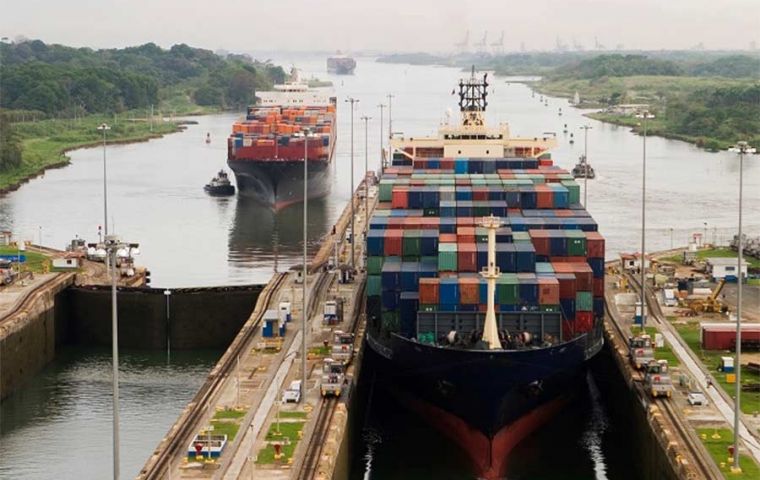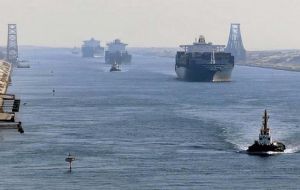MercoPress. South Atlantic News Agency
Queues of vessels waiting to cross the Panama Canal as post pandemic global trade picks up
 This week some 101 vessels were awaiting clearance to make the 64km journey through the canal, six units more than the average recorded so far this year
This week some 101 vessels were awaiting clearance to make the 64km journey through the canal, six units more than the average recorded so far this year  In the Suez Canal also the total number of ships that passed through the 193 km waterway increased by 6.3% year-on-year in April to 1,929 ships.
In the Suez Canal also the total number of ships that passed through the 193 km waterway increased by 6.3% year-on-year in April to 1,929 ships. Global transportation bottlenecks that have surged since the pandemic have shaken industries, consumers, deliveries, and prices. Clear evidence of this can be seen in the current Panama Canal queues of vessels.
This week some 101 vessels were awaiting clearance to make the 64km journey through the canal, six units more than the average recorded so far this year according to Canal sources quoted by Bloomberg.
The Panama canal saw record amounts of cargo passing through its locks in the most recent fiscal year as trade restrictions between China and the US eased. China reopened grains, pork, and liquefied natural gas market to US sales.
Moreover, a US$ 5.25 billion expansion inaugurated in 2016 allowed larger vessels from Asia to reach the US East Coast quicker, avoiding lingering congestion at the ports of California.
US imports of Asian goods arriving on the West Coast fell 3.4% in the first quarter compared to a year earlier, while the number of goods entering the East Coast rose 12.9%, according to freight analysts at Xeneta. Shipments along the coast of the Gulf of Mexico rose 31.1%.
Anyhow the ripple effects of Chinese lockdowns are starting to be felt. After the flow of vessels through the canal increased by 18% in April compared to the same month in the previous year, the channel is now seeing a delayed effect of Beijing’s “covid zero” policy, said Panama Canal Authority head Ricaurte Vasquez.
“Although the pace may differ and the origin and destination may shift slightly, once the lockdown is normalized, we expect to see orders flowing and products being shipped,” he said
Vasquez said that the situation should stabilize once Chinese factories learn to live with Covid. Transport can adapt as long as the resumption is gradual, especially because the market is still “very strong in demand for ship availability.”
In related news, from Egypt, the Suez Canal recorded its highest monthly revenue in April after invoicing US$ 629 million in ship transit fees as traffic recovers from the impact of the pandemic, said the authority that manages the waterway.
Monthly revenue in April was 13.6% higher than a year ago, confirmed Osama Rabie, the president of the authority, in a statement. The total number of ships that passed through the 193 km waterway linking the Red and Mediterranean Seas increased by 6.3% year-on-year to 1,929 ships.
These ships transported cargo with 114.5 million tons, the highest accumulated monthly net payload to transit the waterway.
The number of oil tankers, liquefied natural gas tankers, and container ships increased, respectively, by 25.8%, 12%, and 9% in April from a year earlier.
In addition to the impact of the pandemic, the flow at the canal was disrupted after a container ship ran aground in the channel in late March.




Top Comments
Disclaimer & comment rulesCommenting for this story is now closed.
If you have a Facebook account, become a fan and comment on our Facebook Page!